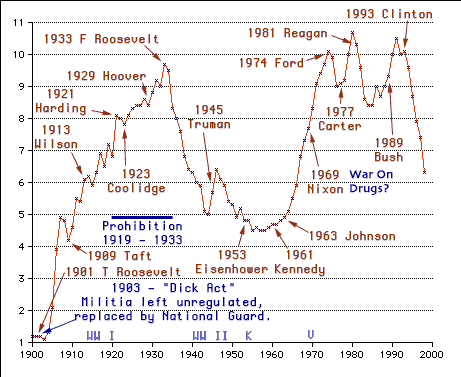 |
Homicide Rates USA, 1900 - 1998
 |
Homicide Rates USA, 1900 - 1998
While the gun control advocates prefer to compare the US to other (selected) countries, the Second Amendment advocates often prefer to show the results of our own attempts at gun control. Orrin Hatch, chairman of the Senate Subcommittee on the Constitution, put it this way.
If gun laws in fact worked, the sponsors of this type of legislation should have no difficulty drawing upon long lists of examples of crime rates reduced by such legislation. That they cannot do so after a century and a half of trying - that they must sweep under the rug the southern attempts at gun control in the 1870-1910 period, the northeastern attempts in the 1920-1939 period, the attempts at both Federal and State levels in 1965-1976 - establishes the repeated, complete and inevitable failure of gun laws to control serious crime.
Hatch's quote might be a little strong. Certainly, there is no evidence that gun control helped during these periods. However, during roughly the same times as the gun control experiments, other social experiments were underway. In the south they were trying to maintain white supremacy. In the 1920s and 1930s northeast, Prohibition era gangster violence was the problem. The 60s and 70s waves of gun control coincided with drug violence. Social control leads to violence which leads to gun control. With 20 20 hindsight, it seems clear that Prohibition and the KKK were bad ideas. Modern drugs are more deadly than alcohol. Judgment is still pending on the War on Drugs.
Some Second Amendment advocates contend that taking away guns is a first step in taking away freedom. Gun control advocates often dismiss this. Since the Founding Father's time, democracy and non violent revolution have proven themselves. The Militia is not as dominant a force for change as it once was. Still, is it coincidence that the major gun control thrusts coincided with the Reconstruction, Prohibition and the War on Drugs? Government efforts at social control - however well or poorly intended - have potentially lethal side effects.
While the above chart shows increased homicides during given periods, it does not and cannot establish the cause of the increase. In the 1920s, how much violence was the Prohibition, how much was the gun control laws, and how much was other factors? The above chart was based on 99 data entries, one per year. There simply is not enough data there to reliably isolate causality. Thus, as in the international statistic comparison preferred by the gun control advocates, this form of argument is not conclusive. It can raise emotion and convince those who want to be convinced. It cannot settle the issue.
I placed the presidents on the above chart just to help associate the homicide rates with the rest of history. I'm not suggesting that presidents should get the credit or blame for the changes in homicide rates, but the curves do tend to shift following inaugurations, and tend to agree with my opinions of the merits of our recent leaders.
My knowledge of 1903's Dick Act comes almost entirely from a pro gun control paper, Have You Seen Your Militia Lately? In the late 1800s, Congress required (at least on paper) for fit males to be armed. All were required to have arms, ammunition and sufficient military equipment to take to the field in an emergency. Can a lack of emergencies be a problem? The Indian Wars were essentially over. The threat of ocean raids from overseas powers was negligible. Neither Mexico or Canada were a military threat. None of this has changed. If the function of the militia is to enforce the law, suppress insurrection and repel invasions, there was and remains little need for two of the three functions. Teddy Roosevelt in his 1901 inaugural claimed the militia was obsolete and useless. He was two thirds correct. He didn't think he had a problem with enforcing the law. At the time, by modern standards, he didn't have a problem enforcing the law.
The 1903 Dick Act divided the militia into the organized and unorganized militia. The organized militia in time became the modern National Guard. A pattern of increased federal finance and control of the National Guard started with the Dick Act. The unorganized militia, the armed body of the people, "necessary to the security of a free State" received no training, no funding, and no guidance. The requirement for fit adult males to maintain weapons in a condition ready to use vanished. I don't have a problems with the Guard continuing essentially as it is, but should the unorganized militia remain totally neglected?
Have you seen your militia lately?
|
|
|
|
More Guns Less Crime - USA - World On Killing - White House Study - Children |